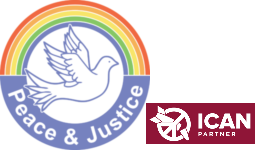On 29 March Yamada Reiko, Vice Chair and Yamada Midori of Tokyo Federation of A-Bomb Sufferers visited the Peace and Justice Centre and shared their stories of surviving the bombing of Hiroshima. We presented each of them with a tartan origami crane and told them about our 140,000 Origami Cranes project which aims to make that number of cranes to visualise and remember the people who were killed by the Hiroshima bomb in 1945 alone.
 They told us their stories, bringing to us a much deeper understanding of the suffering caused by the use of nuclear weapons. Their witness affected us profoundly so that we were re-inspired to our commitment to continue to raise awareness and to campaign for these terrible weapons to be forever banned.
They told us their stories, bringing to us a much deeper understanding of the suffering caused by the use of nuclear weapons. Their witness affected us profoundly so that we were re-inspired to our commitment to continue to raise awareness and to campaign for these terrible weapons to be forever banned.
Reiko was herself 11 years of age and in the yard of her school in Hiroshima when the bomb was dropped on 6th of August 1945. Her account of the day and the aftermath of were deeply moving. She told of how every family in her neighbourhood had victims of the bomb. “A good friend of mine was waiting for their mother to return home, when a moving black lump crawled into the house; they first thought it was a big black dog but soon realized it was their mother. She collapsed and died, leaving her 5 children behind…. From the third day dead bodies were brought to the playground of my school. They were cremated one after another. The town was filled with black smoke and the smell of burning bodies…. We planted sweet potato seeds in the schoolyard. On the day of harvest, as we cut the ground, human bones came out with potatoes and we screamed to see them. They were served for lunch but we could not eat them.”
Yamada Midori is a second generation Hibakusha, born in 1949, after the bombing.
 She suffered breast cancer at age 34. Her father was mayor of her small town and went everyday for a week to find missing people and was exposed to radiation. She shared with us a copy of her beautiful and sad book telling the story of her brother Jiro-chan who was 13 years old at the time of the bombing. He was in middle school in Hiroshima and on 6 August he and his classmates were mobilized to work on house demolition, making firebreaks on a street very close to ground zero. When the bomb fell he was trapped under the fallen building but crawled out. Just then the debris burst into flames and all his classmates were consumed by the flames and died. After that Jiro-chan did not speak of that day until, after the Fukushima nuclear plant disaster. Before Japan was the victim of the US bomb, this time Japan was responsible. Then, aged 80 he began to speak saying “As one who experience the tragedy I should have informed many people of the atrocity of the atomic bombings. It should be my mission as a survivor…the way to remember and console the souls of my friends who perished.” Midori’s little gem of a book, made for children, says “He opened his heart and now he talks as if he offers prayers to his deceased friends.”
She suffered breast cancer at age 34. Her father was mayor of her small town and went everyday for a week to find missing people and was exposed to radiation. She shared with us a copy of her beautiful and sad book telling the story of her brother Jiro-chan who was 13 years old at the time of the bombing. He was in middle school in Hiroshima and on 6 August he and his classmates were mobilized to work on house demolition, making firebreaks on a street very close to ground zero. When the bomb fell he was trapped under the fallen building but crawled out. Just then the debris burst into flames and all his classmates were consumed by the flames and died. After that Jiro-chan did not speak of that day until, after the Fukushima nuclear plant disaster. Before Japan was the victim of the US bomb, this time Japan was responsible. Then, aged 80 he began to speak saying “As one who experience the tragedy I should have informed many people of the atrocity of the atomic bombings. It should be my mission as a survivor…the way to remember and console the souls of my friends who perished.” Midori’s little gem of a book, made for children, says “He opened his heart and now he talks as if he offers prayers to his deceased friends.”
Following their visit to the P&J Centre Midori and Reiko headed down to the Scottish Parliament to meet with First Minister Nicola Sturgeon. The following day they visited Faslane Peace Camp and saw the Faslane Naval Base where Trident nuclear weapons are based.
For more information on and to contribute to the 140,000 Cranes project please visit: https://peaceandjustice.org.uk/peace-organisations/140000-origami-cranes-project/
Photos by David Mackenzie (group) and Brian Larkin (Midori).

